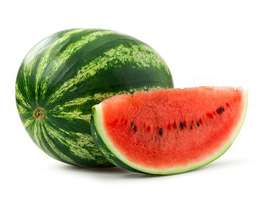Melon melange sorted out

An error made over 80 years ago has led botanists to believe that the edible watermelon originated in South Africa. LMU researchers have now cleared up the confusion and shed new light on the evolution of the juicy fruit.
Type specimens are the "standard units" of biological systematics. These unique specimens are permanently maintained in museum collections, ensuring that they are always available for reference. The type specimen for what is commonly known as the watermelon is part of the herbarium assembled by Linnaeus's student, and later successor, Carl Peter Thunberg, which is held in the Swedish city of Uppsala. Now, a genetic analysis carried out by LMU botanist Professor Susanne Renner and her doctoral student Guillaume Chomicki has revealed that the herbarium specimen can be clearly distinguished from the watermelon with the sweet and succulent red pulp that is cultivated and enjoyed all over the world. "In fact, this type specimen is not even a close relative of the edible watermelon," Renner says.
The muddle revealed by this surprising finding most probably resulted from an erroneous merging of species names. Thunberg collected the type specimen near Cape Town in South Africa in 1773. "As a student and fellow-countryman of the world famous taxonomist Carl von Linné, who had described and classified the cultivated form of the watermelon a few years earlier, Thunberg could not possibly have confused his plant with the true watermelon," Renner says. "His own description certainly supports this assumption: He describes the fruits of his plant as dry and bitter, and covered in wooly hairs. Indeed, this last feature explains why Thunberg named it Citrullus lanatus – 'wooly melon.'"
Misclassification of the type specimen occurred in the early 1930s, when Thunberg's and Linné's melons were mistakenly merged into one species by a well-known American expert on crop plants. A number of factors contributed to this error. – The American author had not examined the type specimens, and methods of sequence analysis of DNA only became available much later. Furthermore, conservation of dried melon fruits and melon flowers is very difficult. The type specimens of both melon species in Uppsala now consists of a few dried leaves, which can no longer be unequivocally classified morphologically. "As a result of the confusion, the watermelon has been erroneously referred to as Citrullus lanatus in the scientific literature since the 1930s," says Renner. "The misnomer now appears in thousands of publications."
The new findings not only correct this long-standing error, they also elucidate the otherwise enigmatic origins of the watermelon. Because Thunberg's type specimen of the wooly melon was found in South Africa, it had been assumed that the true watermelon must have originated there. However, no wild watermelon populations are known in South Africa today. On the other hand, wild forms of the plant are present in West Africa. "We have now analyzed genomic regions of several Citrullus species for the first time, and investigated the relationships between them. Our results show that the watermelon in fact evolved in tropical West Africa, and diverged from its wild sister species around 3 million years ago. In addition, it turns out that the desert watermelon has six extant relatives, rather than two, as previously assumed," Renner explains. The South African species belongs not to the watermelons, but to the citron melons, which form a separate group and were independently domesticated.
"Our results shed new light on the evolutionary history of the watermelon, and may be of interest to plant breeders," says Renner. Breeders in search of agronomically useful traits for introduction into the edible watermelon would be well advised to investigate their wild relatives in West Africa. With respect to the nomenclature issue, Renner proposes that the name Citrullus lanatus should be retained for the edible watermelon. "Scientifically speaking and accepting the principle of priority, the water melon should be renamed. But it is an economically important fruit and is referred to by its current scientific name in thousands of scholarly publications. In such a case, it makes more sense simply to assign the name Citrullus lanatus to a new type specimen – a sweet and edible melon," Renner concludes.
More information: "Watermelon origin solved with molecular phylogenetics including Linnaean material: another example of museomics" New Phytologist 31 OCT 2014. DOI: 10.1111/nph.13163
Journal information: New Phytologist
Provided by Ludwig Maximilian University of Munich














